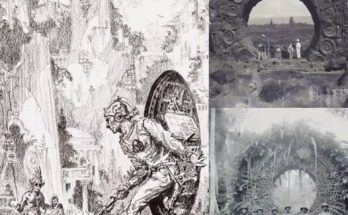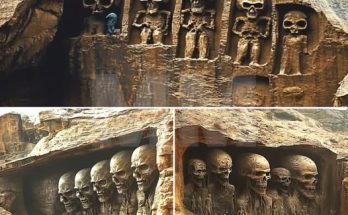Antarctica, one of the most desolate and inhospitable regions on Earth, has once again proven itself to be a treasure trove of mysteries hidden beneath its ancient ice. A recent expedition by a team of scientists made a shocking discovery: the fossilized remains of a massive humanoid creature, unlike anything previously documented in the annals of natural history.
The discovery was made during a geological survey to study the effects of climate change on the Antarctic ice sheet. Drilling through dense layers of ice near an isolated glacier, they uncovered a partially frozen figure embedded in the crystalline depths. Initial observations revealed a massive skeletal structure, nearly three times the size of an average human, with exaggeratedly elongated limbs and a skull displaying both human and supernatural features.
The creature, preserved in nearly pristine conditions, lies in a thick layer of ice, with parts of its anatomy exposed. Its rib cage and muscular structure, though fossilized, suggest extraordinary strength and durability. Its skull, with cavernous eye sockets and menacing dentition, has drawn comparisons to both early hominids and mythical giants described in folklore.
Standing, the creature would have reached a height of at least 12 feet. What makes this even more intriguing is its apparent age. Carbon dating of the surrounding ice sheets suggests the fossils may be millions of years old, dating back to a period long before humans existed on Earth.
The discovery has sparked heated debate among scientists and researchers worldwide. One theorizes that the creature could be a previously unknown species of ancient hominid that evolved in extreme isolation, adapting to hostile environments in ways previously thought impossible. Another theorizes that it could be an entirely distinct branch of evolution, unrelated to humans or any known species, suggesting the possibility of life forms that predated or coexisted with early terrestrial life.
The more speculative theories consider the possibility of extraterrestrial origins. The creature’s anatomical structure, particularly the shape of its skull and teeth, has fueled claims that it could be linked to ancient accounts of alien visitations or interstellar species.
Local legends among indigenous Antarctic explorers, rarely documented in traditional literature, speak of “ice giants,” or beings that once roamed the frozen continent during a mythical golden age. While such stories have often been dismissed as folklore, this discovery has led some to reconsider their potential basis in reality. Could these ancient tales describe encounters with a now-extinct species?
This shocking discovery raises profound questions about Earth’s history and evolutionary timeline. If confirmed as a unique species, it would suggest that the history of life on our planet is far more complex than previously understood. It may also hint at forgotten eras in Earth’s past, where conditions allowed the emergence of creatures that defy our current scientific frameworks.
The research team is now focused on safely extracting the fossil from its frozen tomb for further study. Advanced imaging and genetic analysis techniques will be used to unravel the secrets of this extraordinary creature. From now on, the frozen fossils will remain under constant observation, awaiting transport to a secure laboratory.



